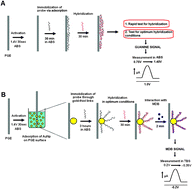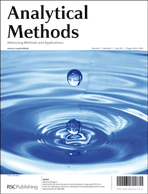In the presented study, a novel method is introduced that demonstrates the electrochemical detection of influenza B virus based on DNA hybridisation. The detection utilised gold nanoparticles (AuNPs) and Meldola's Blue (MDB), which is utilised as an intercalator label. The developed methodology, combined with a disposable pencil graphite electrode (PGE) and differential pulse voltammetry (DPV), was performed using both synthetic oligonucleotides and polymerase chain reaction (PCR) amplicons. The electrochemical oxidation response of guanine (approximately +0.1 V) and the voltammetric reduction signal of MDB (approximately −0.2 V) were measured before and after hybridisation reactions between a single strand DNA probe and its complementary target strain (synthetic target or denatured PCR samples). Before the immobilisation of the synthetic DNA probe of influenza type B virus, the transducer surface was interacted with AuNPs solution using a simple wet adsorption method. AuNP immobilisation was confirmed with cyclic voltammetry (CV) and electrochemical impedance spectroscopy (EIS) to characterise the recognition surface of the genosensor. After the interaction between the PGE and AuNPs, a thiol-linked DNA probe was immobilised onto the nanoparticle-covered surface. When hybridisation occurred between the probe and its synthetic targets or specific PCR products, the highest MDB signal was observed. The probes were also challenged with equal quantities of non-complementary DNA at the PGE surface for the determination of biosensor selectivity. AuNP-coated electrodes showed high sensitivity and selectivity, specifically in real samples for the detection of the hybridisation reaction. The results obtained in the presented study indicated that the electrode surface area could be enhanced with AuNPs. The detection limit of the genosensor was found to be 54 picomoles for the synthetic target and 3.3 × 107 molecules for the real samples (PCR) in 30 μL of sample volume. Future prospects and analytical performance of the sensor is briefly discussed.

You have access to this article
 Please wait while we load your content...
Something went wrong. Try again?
Please wait while we load your content...
Something went wrong. Try again?


 Please wait while we load your content...
Please wait while we load your content...